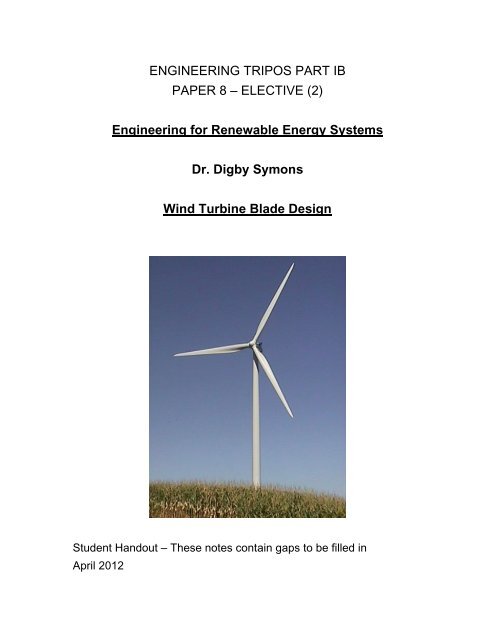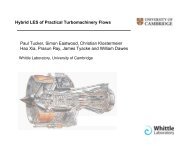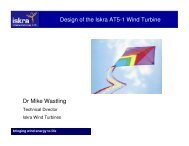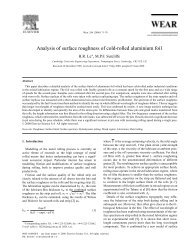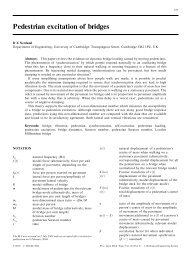You also want an ePaper? Increase the reach of your titles
YUMPU automatically turns print PDFs into web optimized ePapers that Google loves.
ENGINEERING TRIPOS PART IB<br />
PAPER 8 – ELECTIVE (2)<br />
Engineering for Renewable Energy Systems<br />
Dr. <strong>Digby</strong> <strong>Symons</strong><br />
Wind Turbine <strong>Blade</strong> Design<br />
Student Handout – These notes contain gaps to be filled in<br />
April 2012
CONTENTS<br />
1 Introduction ............................................................................................................. 3<br />
2 Wind Turbine <strong>Blade</strong> Aerodynamics .................................................................. 4<br />
2.1 Aerofoil Aerodynamics .................................................................................... 4<br />
2.2 Wind Turbine <strong>Blade</strong> Kinematics..................................................................... 7<br />
3 <strong>Blade</strong> Element Momentum Theory .................................................................. 12<br />
3.1 Momentum changes ...................................................................................... 12<br />
3.2 <strong>Blade</strong> forces .................................................................................................... 13<br />
3.3 Induction factors ............................................................................................. 14<br />
3.4 Iterative procedure ......................................................................................... 15<br />
4 Optimum Performance of a Wind Turbine..................................................... 19<br />
4.1 Turbine Power................................................................................................. 19<br />
4.2 Optimal Induction Factors............................................................................. 19<br />
4.3 Dependency of Power on Tip Speed Ratio................................................ 20<br />
5 <strong>Blade</strong> Loading....................................................................................................... 21<br />
5.1 Aerodynamic Loading.................................................................................... 21<br />
5.2 Centrifugal Loading........................................................................................ 23<br />
5.3 Self Weight loading ........................................................................................ 24<br />
5.4 Combined Loading......................................................................................... 25<br />
5.5 Storm Loading ................................................................................................ 26<br />
More detailed coverage of the material in this handout can be found in various<br />
books, e.g.<br />
Aerodynamics of Wind Turbines, Hansen M.O.L. 2000<br />
Wind Energy Explained, Manwell J.F., McGowan J.G & Rogers A.L. 2002<br />
2
1 INTRODUCTION<br />
1.1.1 Aim<br />
Preliminary design of a wind turbine:<br />
1.1.2 Wind turbine type<br />
•<br />
•<br />
•<br />
Horizontal axis wind turbine (HAWT) with 3 blade upwind rotor – the<br />
“Danish concept”:<br />
1.1.3 Load cases<br />
We will consider two load cases:<br />
Fig. 1<br />
1) Normal operation – continuous loading<br />
• Aerodynamic, centrifugal and self-weight loading<br />
•<br />
•<br />
2) Extreme wind loading – storm loading with rotor stopped<br />
•<br />
3
2 WIND TURBINE BLADE AERODYNAMICS<br />
2.1 Aerofoil Aerodynamics<br />
2.1.1 Lift, drag and angle of attack<br />
α<br />
2.1.2 Lift and drag coefficients<br />
V<br />
c<br />
Fig. 2<br />
Define non-dimensional lift and drag coefficients<br />
(1)<br />
4
2.1.3 Variation of lift and drag coefficients with angle of attack<br />
How does lift and drag vary with angle of attack α ?<br />
L C C ,<br />
D<br />
Fig. 3<br />
Below stall a good approximation is:<br />
Stall:<br />
Fig. 4<br />
2.1.4 Application of 2D theory to wind turbines<br />
C L<br />
C D<br />
• Tip leakage means flow is not purely two dimensional<br />
• Wind turbine blades are spinning with an angular velocity ω<br />
• The angle of attack depends on the relative wind velocity<br />
direction.<br />
α<br />
(2)<br />
5
2.1.5 Example aerofoil shape used in wind turbines<br />
Lift and drag coefficients for the NACA 0012 symmetric aerofoil<br />
(Miley, 1982)<br />
CD<br />
CL<br />
Fig. 5<br />
Fig. 6<br />
6
2.2 Wind Turbine <strong>Blade</strong> Kinematics<br />
2.2.1 <strong>Blade</strong> rotation<br />
V<br />
θ<br />
ϖ r<br />
Fig. 7<br />
Relative<br />
wind<br />
Fig. 8a Fig. 8b<br />
α<br />
θ<br />
7
2.2.2 Wake rotation<br />
Axial velocity<br />
V 0<br />
0<br />
Tangential velocity<br />
0<br />
R<br />
V ( 1−<br />
a)<br />
0<br />
Rotor<br />
plane<br />
Fig. 9<br />
V ( 1−<br />
2a)<br />
0<br />
8
2.2.3 Annular control volume<br />
Wake rotates in the opposite sense to the blade rotation ω<br />
V V ( 1−<br />
a)<br />
0<br />
2.2.4 Wind and blade velocities<br />
0<br />
r<br />
Fig. 10<br />
Induced wind velocities seen by blade + blade motion<br />
V ( 1−<br />
a)<br />
0<br />
ϖ r a′<br />
Local twist angle of blade = θ<br />
Fig. 11<br />
R<br />
ϖ<br />
V ( 1−<br />
2a)<br />
0<br />
9
2.2.5 <strong>Blade</strong> relative motion and lift and drag forces<br />
Local angle of attack = α<br />
V ( 1−<br />
a)<br />
0<br />
θ<br />
Fig. 12<br />
Relative wind speed Vrel has direction φ = α + θ<br />
where sinφ = V0(<br />
1−<br />
a)<br />
V rel<br />
and cosφ = ωr(<br />
1+<br />
a′<br />
)<br />
V rel<br />
F L and F D are aligned to the direction of<br />
Obtain C L and C D for α = φ −θ<br />
from table or graph for aerofoil used<br />
Vrel<br />
(3)<br />
10
2.2.6 Resolve forces into normal and tangential directions<br />
V rel<br />
Fig. 13<br />
We can resolve lift and drag forces into forces normal and tangential<br />
to the rotor plane:<br />
We can normalize these forces to obtain force coefficients:<br />
Hence:<br />
C N = CL<br />
cosφ + CD<br />
sinφ<br />
CT = CL<br />
sinφ − CD<br />
cosφ<br />
F D<br />
F L<br />
(4)<br />
(5)<br />
(6)<br />
11
3 BLADE ELEMENT MOMENTUM THEORY<br />
Split the blade up along its length into elements.<br />
Use momentum theory to equate the momentum changes in the air<br />
flowing through the turbine with the forces acting upon the blades.<br />
Pressure distribution along curved streamlines enclosing the wake<br />
does not give an axial force component.<br />
(For proof see one-dimensional momentum theory, e.g. Hansen)<br />
3.1 Momentum changes<br />
V V ( 1−<br />
a)<br />
ϖ r a′<br />
0<br />
0<br />
r<br />
Fig. 14<br />
R<br />
ϖ<br />
V ( 1−<br />
2a)<br />
Thrust from the rotor plane on the annular control volume is δ N<br />
δ N = m&<br />
V − u ) = 2πrρu(<br />
V − u ) δr<br />
( 0 1<br />
0 1<br />
Torque from rotor plane on this control volume is δ T<br />
δT = m&<br />
ru = 2m & ϖr<br />
a′<br />
θ<br />
2<br />
0<br />
2 ϖr<br />
a′<br />
(7)<br />
(8)<br />
12
3.2 <strong>Blade</strong> forces<br />
Now equate the momentum changes in the flow to the forces on the<br />
blades:<br />
3.2.1 Normal forces<br />
2<br />
4π<br />
rρV a(<br />
1 a)<br />
δr<br />
0 − =<br />
2<br />
1 V a<br />
= Bρ 0 ( 1−<br />
)<br />
cCNδr<br />
2 2<br />
sin φ<br />
1 ( 1−<br />
a)<br />
Therefore: 4 πra<br />
= B cC<br />
2 N<br />
2 sin φ<br />
Define the rotor solidity: (10)<br />
Hence: (11)<br />
3.2.2 Tangential forces<br />
3 =<br />
4π r ρV0<br />
( 1−<br />
a)<br />
ωa′<br />
δr<br />
2<br />
V ( 1−<br />
a)<br />
rω(<br />
1+<br />
a )<br />
= rBρ cCTδr<br />
2 sinφ<br />
cosφ<br />
1 0 ′<br />
1 ( 1+<br />
a′<br />
)<br />
Therefore: 4 πr<br />
a′<br />
= B cCT<br />
2 sinφ<br />
cosφ<br />
(9)<br />
(12)<br />
Use the rotor solidity σ : (13)<br />
13
3.3 Induction factors<br />
These equations can be rearranged to give the axial and angular<br />
induction factors as a function of the flow angle.<br />
Axial induction factor:<br />
Angular induction factor: (14)<br />
However, recall that the flow angleφ is given by (3):<br />
( 1−<br />
a)<br />
V<br />
tanφ<br />
=<br />
0<br />
( 1+<br />
a′<br />
) ωr<br />
Because the flow angle φ depends on the induction factors a and a'<br />
these equations must be solved iteratively.<br />
14
3.4 Iterative procedure<br />
• Choose blade aerofoil section.<br />
• Define blade twist angle θ and chord length c as a function of<br />
radius r.<br />
• Define operating wind speed V0 and rotor angular velocity ω .<br />
For a particular annular control volume of radius r :<br />
1. Make initial choice for a and a’ , typically a = a’ = 0.<br />
2. Calculate the flow angle φ (3).<br />
3. Calculate the local angle of attack α = φ −θ<br />
.<br />
4. Find C L and C D for α from table or graph for the aerofoil used.<br />
5. Calculate and<br />
N<br />
C T<br />
C (6).<br />
6. Calculate a and a’ (14).<br />
7. If a and a’ have changed by more than a certain tolerance<br />
return to step 2.<br />
8. Calculate the local forces on the blades (7) & (8).<br />
3.4.1 Example wind turbine<br />
<strong>Blade</strong> element theory has been applied to an example 42 m diameter<br />
wind turbine with the parameters below. Each element has a radial<br />
thickness δ r = 1m.<br />
Incident wind speed V 0<br />
8 m/s<br />
Angular velocity ϖ 30 rpm<br />
<strong>Blade</strong> tip radius R 21 m<br />
Tip speed ratio λ = ωR<br />
/V0<br />
Number of blades B 3<br />
Air density ρ 1.225 kg/m 3<br />
15
<strong>Blade</strong> shape (chord c and twist θ ) are based on the Nordtank NTK<br />
500/41 wind turbine (see Hansen, page 62) and are plotted below<br />
(Figs. 15 & 16).<br />
Chord c (m)<br />
<strong>Blade</strong> twist angle (deg)<br />
1.8<br />
1.6<br />
1.4<br />
1.2<br />
1<br />
0.8<br />
0.6<br />
0.4<br />
0.2<br />
0<br />
0 2 4 6 8 10 12 14 16 18 20 22<br />
20<br />
18<br />
16<br />
14<br />
12<br />
10<br />
8<br />
6<br />
4<br />
2<br />
Radius r (m)<br />
Fig. 15: Chord c<br />
0<br />
0 2 4 6 8 10 12 14 16 18 20 22<br />
r (m)<br />
Fig. 16: <strong>Blade</strong> twist angle θ<br />
16
3.4.2 Results of BEM analysis<br />
Axial and angular induction factors a , a’<br />
Induction factors a , a'<br />
0.25<br />
0.20<br />
0.15<br />
0.10<br />
0.05<br />
a<br />
a'<br />
0.00<br />
0 2 4 6 8 10 12 14 16 18 20 22<br />
r (m)<br />
Fig. 17<br />
Flow angle φ and local angle of attack α = φ −θ<br />
Angle (deg)<br />
30<br />
25<br />
20<br />
15<br />
10<br />
5<br />
0<br />
0 2 4 6 8 10 12 14 16 18 20 22<br />
r (m)<br />
Fig. 18<br />
17
Normal and tangential<br />
N<br />
Forces per unit length (N/m)<br />
1100<br />
1000<br />
900<br />
800<br />
700<br />
600<br />
500<br />
400<br />
300<br />
200<br />
100<br />
F T<br />
F forces on blade<br />
0<br />
0 2 4 6 8 10 12 14 16 18 20 22<br />
Total power (3 blades)<br />
r (m)<br />
Fig. 19<br />
and therefore the coefficient of performance<br />
FN (N/m)<br />
FT (N/m)<br />
18
4 OPTIMUM PERFORMANCE OF A WIND TURBINE<br />
4.1 Turbine Power<br />
The power provided by an annular control volume can be obtained<br />
from the torque (8) as<br />
3<br />
2<br />
δ P = ϖδT<br />
= 4π<br />
r ρV<br />
( 1−<br />
a)<br />
ω a′<br />
δr<br />
(15)<br />
0<br />
The total turbine power can therefore be found by integrating over the<br />
length R of the blades:<br />
R<br />
∫<br />
2<br />
3<br />
P = 4πρω V ( 1−<br />
a)<br />
a′<br />
r δr<br />
(16)<br />
0<br />
0<br />
We can write this expression in a non-dimensional form as:<br />
λ<br />
8<br />
3<br />
C = ( 1−<br />
) ′<br />
p a a x δx<br />
(17)<br />
∫<br />
2<br />
λ 0<br />
Where λ = ωR<br />
/V0<br />
is the tip speed ratio and x = ωr<br />
/V0<br />
is the local<br />
rotational speed ratio.<br />
4.2 Optimal Induction Factors<br />
For an optimally performing blade the local angle of attack will be<br />
below stall. In this case a and a’ are not independent because,<br />
according to potential flow theory, the total induced velocity must be<br />
perpendicular to the local velocity (see e.g. Hansen 2000) thus<br />
( 1−<br />
a)<br />
V<br />
tanφ<br />
=<br />
0<br />
( 1+<br />
a′<br />
) ωr<br />
which provides the following relationship:<br />
a′ ϖr<br />
= (18)<br />
aV<br />
0<br />
2<br />
x a′<br />
( 1+<br />
a′<br />
) = a(<br />
1−<br />
a)<br />
(19)<br />
To optimize the power we need to maximize ( 1−<br />
a ) a′<br />
(17) and this<br />
requires that<br />
1−<br />
3a<br />
′ =<br />
4a<br />
−1<br />
a (20)<br />
This optimal relationship between the induction factors is plotted<br />
below in Fig. 20. As expected from the Betz limit analysis the<br />
optimum value of a approaches 1/3.<br />
19
1<br />
0.9<br />
0.8<br />
0.7<br />
0.6<br />
a, a' 0.5<br />
0.4<br />
0.3<br />
0.2<br />
0.1<br />
0<br />
0 2 4 6 8 10<br />
Local speed ratio x = ωr<br />
/V0<br />
Fig. 20: Optimal induction factors<br />
4.3 Dependency of Power on Tip Speed Ratio<br />
Substitution of (19) and (20) into (17) provides the dependency of the<br />
power coefficient C p on the tip speed ratio λ (Fig. 21).<br />
27<br />
C<br />
16<br />
p<br />
1<br />
0.9<br />
0.8<br />
0.7<br />
0.6<br />
0.5<br />
0.4<br />
0.3<br />
0.2<br />
0.1<br />
0<br />
0 2 4 6 8<br />
Tip speed ratio<br />
λ =<br />
ωR<br />
V<br />
Fig. 21: Turbine efficiency<br />
0<br />
a<br />
a'<br />
10<br />
20
5 BLADE LOADING<br />
5.1 Aerodynamic Loading<br />
Once values of a and a’ have converged the blade loads can be<br />
calculated (9) & (12):<br />
2 2<br />
1 V a<br />
FN<br />
ρ 0 ( 1−<br />
)<br />
=<br />
cC<br />
2 N<br />
2 sin φ<br />
F<br />
T<br />
1 V a ωr<br />
a<br />
ρ 0 ( 1−<br />
) ( 1+<br />
′ )<br />
=<br />
cC<br />
2 sinφ<br />
cosφ<br />
5.1.1 Stresses at blade root<br />
T<br />
Fig. 22<br />
The normal force FN<br />
causes a “flapwise” bending moment at the root<br />
of the blade.<br />
M<br />
N<br />
=<br />
R<br />
∫<br />
F<br />
N<br />
rmin<br />
( r − rmin<br />
) dr<br />
The tangential force F T causes a tangential bending moment at the<br />
root of the blade.<br />
M<br />
T<br />
=<br />
R<br />
∫<br />
F<br />
T<br />
rmin<br />
( r − rmin<br />
) dr<br />
For convenience we will neglect the relatively small twist of the blade<br />
cross section and assume that these bending moments are aligned<br />
with the principal axes of the blade structural cross section. The<br />
maximum tensile stress due to aerodynamic loading is therefore<br />
given by:<br />
21
5.1.2 Deflection of blade tip<br />
dS<br />
FN =<br />
dr<br />
dM<br />
S =<br />
dr<br />
2<br />
d v M<br />
− ≈ κ =<br />
2<br />
dr [ EI ]( r)<br />
Simplified approach:<br />
• Split blade into elements.<br />
Fig. 23<br />
• Assume that for each element the loading FN<br />
and flexural<br />
rigidity EI are constant.<br />
• Find the shear force and bending moment transferred between<br />
each element.<br />
• Use data book deflection coefficients for each element.<br />
• Find the cumulative rotations along the blade.<br />
• Find the cumulative deflections along the blade.<br />
22
5.2 Centrifugal Loading<br />
The large mass of a wind turbine blade and the relatively high angular<br />
velocity can give rise to significant centrifugal stresses in the blade.<br />
Fig. 24<br />
Consider equilibrium of element of blade:<br />
Simplified method:<br />
dFc 2<br />
= −m(<br />
r)<br />
ω r<br />
dr<br />
• Split blade up into elements.<br />
σ c =<br />
Fc ( r)<br />
A(<br />
r)<br />
• Assume each element has a constant cross-section<br />
Fig. 25<br />
23
5.3 Self Weight loading<br />
The bending moment at the blade root due to self weight loading can<br />
dominate the stresses at the blade root. Because the turbine is<br />
rotating the bending moment is a cyclic load with a frequency of<br />
f = ω / 2π<br />
. The maximum self-weight bending moment occurs when a<br />
blade is horizontal.<br />
Fig. 26<br />
Bending moment at root of blade due to self weight<br />
M<br />
sw<br />
=<br />
R<br />
∫<br />
rmin<br />
m(<br />
r)<br />
g(<br />
r − rmin<br />
) dr<br />
where m(r) is the mass of the blade per unit length. This is a<br />
tangential (edge-wise) bending moment and therefore the maximum<br />
bending stress due to self-weight is given by:<br />
σ<br />
M sw b<br />
max, sw =<br />
I NN 2<br />
Simplified method: split blade into elements, assume each element<br />
has uniform self weight.<br />
24
5.4 Combined Loading<br />
σ<br />
M N do<br />
MT<br />
b<br />
max, aero = +<br />
ITT<br />
2 I NN 2<br />
σ c =<br />
σ<br />
Fc ( r)<br />
A(<br />
r)<br />
M sw b<br />
max, sw<br />
I NN 2<br />
=<br />
Fig. 27<br />
Operational maximum stress: σ max = σ max, aero + σ c + σ max, sw<br />
Minimum stress at same location: σ min = σ max, aero + σ c − σ max, sw<br />
25
5.5 Storm Loading<br />
5.5.1 Drag force on blade<br />
<strong>Blade</strong>s parked. Extreme wind speed<br />
1 2<br />
FD ( r)<br />
ρVmaxCD<br />
c(<br />
r)<br />
2<br />
= load per unit length<br />
V max<br />
V max = 50 m/s, c = 1.3m<br />
ρV c<br />
Re = max =<br />
μ<br />
Hence C D =<br />
c<br />
F D<br />
Fig 28<br />
26
5.5.2 Bending moment<br />
Find bending moment at root of blade<br />
= ∫<br />
R<br />
r<br />
M<br />
σ<br />
=<br />
y<br />
M<br />
I<br />
M<br />
σ =<br />
I<br />
min<br />
Ddr rF<br />
= Eκ<br />
do<br />
2<br />
3<br />
3<br />
i<br />
b(<br />
do<br />
− d<br />
I ≈<br />
12<br />
5.5.3 Shear stress<br />
= ∫<br />
R<br />
r<br />
S<br />
min<br />
SA y<br />
q =<br />
c<br />
I<br />
q = τtw<br />
Note:<br />
Ddr F<br />
)<br />
Fig. 29<br />
Fig. 30<br />
High solidity rotor (multi bladed) gives excessive forces on tower<br />
during extreme wind speeds. Therefore use fewer blades.<br />
27


